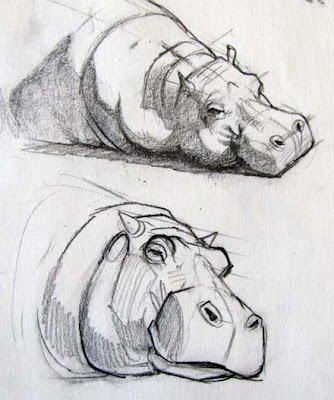
An even simpler idea is to draw a set of lines across the form of any animal or person. It’s a quick way check the placement of all the features. If they’re out of position, you’ll know right away.
In these zoo sketches of a hippo, each head has a set of parallel lines to make sure the ears, eyes, and nostrils are kept in their proper relationship. In the top sketch, I’ve also lightly drawn the center line of the form. I tried to simplify the lighting by massing the shadow as a light, uniform tone.
In the lower sketch, I simplified the forms a bit (note the spherical forms around the eyes). The shading lines follow the cross-section contours, which helps even more to describe the form.







11 comments:
Wow James, I just discovered your blog, thanks to one of your devotees. This lesson is so useful to me. I'm excited to see what else you post in your blog.
Always a great technique to use, helped me lots to over come distortion problems. Sometimes distortion isn't always a bad thing especially if you're trying to create an off the wall toon character.
Something I also come to love is a blue pencil or animation pencil. You can use it to lightly draw all your lines and then add the details later. This pencil is also easily erasable but then you normally don’t have to go that far.
I love this--Its definitely a good practice to work on multiple angles of a subject.
Having a bit of modeling experience with Maya I find myself sometimes creating lattice work along my center lines for each part of the body. Especially to help with contour variations in perspective.
=s=
Thank you. This kind of thing is helpful even to us brush-illiterates who cut and paste things in photoshop.
I'll be studying linear perspective soon myself under Sal Amendola at SVA. I thought it was only good for buildings and objects like vehicles.
So it's good for drawing living things now? I'm sold on linear perspective.
Max,
there's a long tradition of drawing living things (humans for instance) in this way:
-figure out how the body relates to simple geometric placeholders (a head "is" a cube, an arm "is" a cylinder, etc), disregarding details temporarily.
-place the geometric placeholder in space using perspective (for instance, the cube corresponding to the head gets foreshortened in the direction of an adequate vanishing point)
-place again the details of the body on top of the foreshortened geometric placeholder.
You can see wonderful examples of this for instance in the books of Robert Hale.
Sometimes, when the object is small compared to the viewing distance, using a parallel (axonometric) projection may be better than true perspective: it's easier and gives no distortion (which is often good for human features).
I think you did the same with the hippo.
In this video we see Jean Giraud (Moebius) drawing his hero "Blueberry".
Note the light, intuitive and loose drawing style. Yet, right before inking, he checks the perspective of the head with some faintly drawn guide lines.
I've found info on drawing people and animals in perspective to be quite elusive- and I haven't found a drawing book yet that includes it. Thanks for the post! Would love to see more on this subject!
All helpful comments, thanks everyone.
Mario, you're right: the hippos were far enough away that the lines were effectively axonometric, rather than vanishing to a point.
Erik, thanks for the Moebius link. It's always magic to watch someone draw, especially of his caliber.
K Tigress-I agree that in character design and portraiture a subject comes alive when you deliberately throw elements out of alignment, but of course to do that you have to know how to get them right first.
Max, yes, perspective is especially important for figure drawing. One thing that helps is to establish the eye level or horizon right away on a figure drawing, and to keep in mind that you're looking UP at anything above that line and looking DOWN at anything below it.
Post a Comment